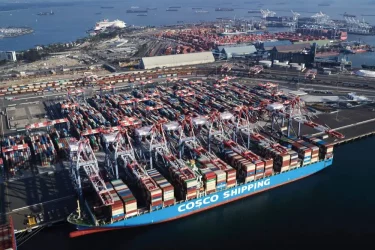The year 2022 does not indicate any likelihood of a sudden decline in ocean shipping rates. This means another year of booming profits for global cargo carriers. However, small businesses and consumers are paying the price. They are forced to pay sky-rocketing freight costs as cargo giants mint profits. The market shows the nature of a spot market where the price of a 40-foot container to the U.S. from Asia stood at $20,000 last year, inclusive of surcharges and premiums, which had initially been at $2,000 a few years ago.
Unlike the big giants like Walmart Inc. and Ikea, who can tackle the high rates, the small exporters and importers cannot easily pass through these costs or weather long periods of stretched cash flows. Amruth Raj, the managing director of Green Gardens, a vegetable processor, says, “Small and medium-sized enterprises are being badly affected. They exploit our desperation.”
The future spells 200% higher elevated prices as tight container capacity and port congestion have maxed up chances for long-term rates in contracts. Achil Yame, Cameroon National Shippers Council, stressed that this inequality is heavy on the African countries. “If nothing is done to reverse the trend, the risk in terms of inflation and food security can grow very, very high.”
Windfall Leading to Inflation
The British International Freight Association is one of the latest who has called on the U.K. government to investigate the “distorted market conditions” in the global container shipping market arena. The surging shipping transportation cost has been responsible for stoking inflation and clouding the recovery.
The Kansas City Fed economist Nicholas Sly has researched and found that a 15% increase in shipping cost leads to a 0.10 percentage point increase in core inflation after a year. He stated that shipping rates are currently a persistent challenge. “These types of shocks tend to last for 12 to 18 months.”
Twenty-five years ago, 20 companies controlled half of the global capacity. Today, it has come down to 10 container lines that contain nearly 85% of the capacity for shipping goods by sea. These lines are based in Asia and Europe, the more familiar ones being Maersk, MSC, France’s CMA CGM SA, and China’s Cosco Shipping Holdings Co. Nine of them operate under vessel sharing agreements called “alliances” though being competitors. These alliances allow them to coordinate schedules and share ship space.
Rising Freight Rates
The pandemic showcased how the carriers drove the market with a bullish frenzy by holding the economy and then ramping it with crazy rates. The contract rates on ocean freight locked in high shipping costs into 2023. A Pennsylvania-based importer MCS Industries Inc., filed complaints against MSC and Cosco, stating that they have been “Operating in tandem to exploit the Covid-19 disruption to profiteer at the expense of U.S. consumers.”
James Hookham, Global Shippers Forum Director, states, “We believe this market needs some investigation to make sure those customers are not being abused. This market is not working to the benefit of everybody.” Mario Cordero, former chairman of the FMC and Executive director at the Port of Long Beach, said it’s a “confluence of factors” that have led to the tangling of the global supply chain in the wake of the pandemic. He states that “I’m not suggesting we’re over this.”
During the first lockdown in March 2020, the Chinese and American economies reopened. Government stimulus payments began flowing, bringing consumer demand for goods such as exercise bikes and home-office desks. By the third quarter of 2021, world trade in goods hit a record $5.6 trillion and was on pace for an equally solid number in the year’s final three months.
Demand Driven by Shortages
The sudden demand disrupted the supply chains as most U.S. ports couldn’t process imports fast enough, trucking companies fell short on drivers, and warehouses ran out of space. Because of port congestion, fully loaded ships stayed put on California beaches for weeks. Suddenly everything halted.
In November 2021, the White House called on the Federal Maritime Commission (FMC) to “use all of the tools at its disposal to ensure free and fair competition.” Since then, the FMC has increased carrier alliances’ monitoring to better track trends and spot potential illegal behavior, such as artificially limiting supply or not competing on prices. The agency’s chairman, Daniel Maffei, says that there are little regulators can do to rein in more widespread potential under current U.S. law. “The fact is that it is very, very difficult, if not impossible, for the FMC to challenge these alliances for violating competition requirements,” said Maffei, noting that he has no evidence that they currently are. “We don’t have the practical tools necessary to challenge it.”
Last year a bipartisan bill was passed in the U.S. aimed to reform U.S. shipping laws. It would give the FMC greater authority, prohibit carriers from discriminating against American cargo, and give businesses more power to challenge carrier fees. The European Commission is “closely monitoring the container shipping industry and is aware that there have been large price increases,” the commission said in a statement. Lori Fullmer, vice president of logistics and carrier management at BassTech International, says she’s had shipments rejected multiple times, “In some cases, there was no getting space on a ship,” she said.
The Sri Lankan Scenario – Slumping Capacity
Exporters of the apparel manufacturing industries in Sri Lanka are struggling to meet orders as carriers shift their vessels to lucrative routes connecting China to the U.S. and Europe, said Sean Van Dort with the Joint Apparel Association Forum Sri Lanka. “Yes, they have to make money, don’t get me wrong — but when you have ten times, twelve times, sixteen times higher freight rates — there’s something radically wrong,” he said.